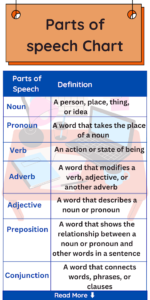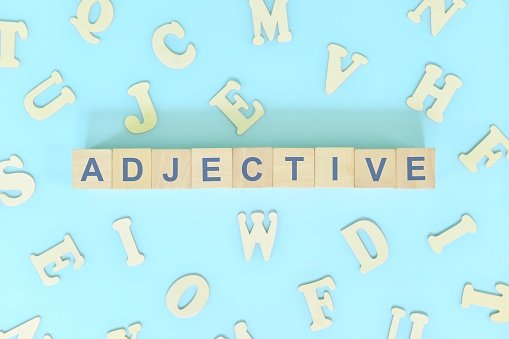Parts of speech refer to the various categories of words in a language that perform different functions in sentences. Understanding the different parts of speech is essential for effective communication, as it helps to clarify the meaning of sentences and promotes clear and concise writing.
In this article, we will discuss the different parts of speech, their functions, and provide a chart to help you understand them better.
Parts of speech Chart
A chart of the parts of speech in English grammar, along with their definitions:
| Part of speech |
Definition |
| Noun |
A person, place, thing, or idea |
| Pronoun |
A word that takes the place of a noun |
| Verb |
An action or state of being |
| Adverb |
A word that modifies a verb, adjective, or another adverb |
| Adjective |
A word that describes a noun or pronoun |
| Preposition |
A word that shows the relationship between a noun or pronoun and other words in a sentence |
| Conjunction |
A word that connects words, phrases, or clauses |
| Interjection |
A word or phrase that expresses strong emotions |
Note that some grammar sources may classify certain words differently or use different terminology, but this chart should cover the most commonly recognized parts of speech in English grammar.
Noun:
A noun is a word that represents a person, place, thing, or idea. Nouns can be singular or plural, concrete or abstract.
Example:
Singular: dog, house, person
Plural: dogs, houses, people
Verb:
A verb is a word that shows an action, occurrence, or state of being. Verbs are the central element of a sentence.
Example:
Action verb: run, jump, swim
Occurrence verb: happen, occur, appear
State of being verb: am, is, are
Adjective:
An adjective is a word that describes or modifies a noun or pronoun. Adjectives provide more information about the noun, including its appearance, color, size, or quantity.
Example:
Red car, big house, small dog
Adverb:
An adverb is a word that modifies a verb, adjective, or another adverb. Adverbs provide more information about the action or description in the sentence.
Example:
Slowly ran, very happy, extremely fast
Pronoun:
A pronoun is a word that takes the place of a noun. Pronouns help to avoid repetition in sentences.
Example:
He, she, it, they
Preposition:
A preposition is a word that shows the relationship between a noun or pronoun and other words in the sentence. Prepositions typically indicate direction, location, or time.
Example:
Under the table, in the park, during the night
Conjunction:
A conjunction is a word that connects words, phrases, or clauses in a sentence. Conjunctions are used to join ideas or show the relationship between different parts of a sentence.
Example:
And, or, but, because
Interjection:
An interjection is a word or phrase that expresses strong emotion or surprise. Interjections are often used to add emphasis to a sentence.
Example:
Wow!, Ouch!, Hey!
Conclusion
In conclusion, understanding the different parts of speech is essential for effective communication and writing. The above chart provides a comprehensive list of the different parts of speech, including their definitions and examples. By mastering these parts of speech, you can improve your writing and communication skills.
FAQ
Q: What is a parts of speech chart?
A: A parts of speech chart is a visual representation of the different categories of words that make up the English language, such as nouns, verbs, adjectives, adverbs, pronouns, prepositions, conjunctions, and interjections.
Q: Why is it important to understand parts of speech?
A: Understanding parts of speech is important for a number of reasons. It can help you identify the function of words in a sentence, which can aid in comprehension and communication. It can also help you improve your writing by giving you a better understanding of how words work together to create meaning.
Q: What are the different parts of speech?
A: There are eight parts of speech: nouns, verbs, adjectives, adverbs, pronouns, prepositions, conjunctions, and interjections.
Q: What is a noun?
A: A noun is a word that represents a person, place, thing, or idea. Examples of nouns include dog, table, love, and happiness.
Q: What is a verb?
A: A verb is a word that expresses action or a state of being. Examples of verbs include run, jump, think, and is.
Q: What is an adjective?
A: An adjective is a word that describes or modifies a noun or pronoun. Examples of adjectives include beautiful, tall, happy, and blue.
Q: What is an adverb?
A: An adverb is a word that describes or modifies a verb, adjective, or other adverb. Examples of adverbs include quickly, very, happily, and slowly.
Q: What is a pronoun?
A: A pronoun is a word that takes the place of a noun or noun phrase. Examples of pronouns include he, she, they, it, and who.
Q: What is a preposition?
A: A preposition is a word that shows the relationship between a noun or pronoun and other words in a sentence. Examples of prepositions include on, in, at, and with.
Q: What is a conjunction?
A: A conjunction is a word that connects words, phrases, or clauses. Examples of conjunctions include and, but, or, and so.
Q: What is an interjection?
A: An interjection is a word or phrase that expresses strong emotion or surprise. Examples of interjections include wow, oh, hey, and ouch.



